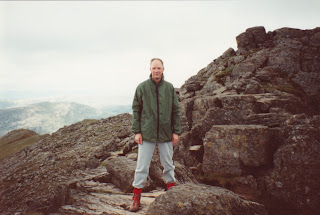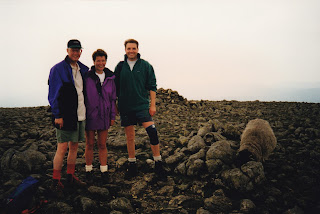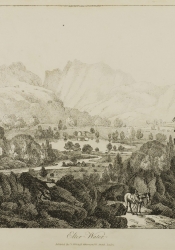Scafell Pike
As I only started posting the detail of our walks in the Lake District in June 2008, soon after I started my blog, there are photos and descriptions that I have never posted before. There was only one place to start for these highlights and that was in 2003 when we stayed at Riverbank Cottage at Skelwith Bridge. On Monday 16th June we found our way to the top of Scafell Pike (photo above) on a lovely sunny day. Starting at the car park at Dungeon Gyll at 9am, we walked down the road to Stool End Farm and down Mickleden to pick up the main path that eventually takes you to the rocky scramble that is the very steep Rossett Gyll as the photo below. I have had to scan photos from our albums as they have not found their way to computer files.
We passed Rossett Pike to reach Angle Tarn before the steady climb to the main crossroads of Esk Hause. This is where we joined the most direct route to Scafell Pike that comes up from Seathwaite in the Derwent Valley to the north. Our route was far longer but we avoided what would have been a very long drive. It is still a fair way to the top of Scafell Pike. My book records "the last hour from Esk Hause is quite hard, up and down, rocky and lots of boulders". We made the summit at 1.45pm, a long four hours and twenty minutes.
We decided to take the long way back via Esk Hause and Bowfell. This meant a descent to Ore Gap before climbing AGAIN to Bowfell summit. Then down to Three Tarns and an easier descent down The Band. I can always rembember the last two hours felt really hard, especially the last mile or so along the road from Stool End Farm. We arrived back at the car park at 7.15pm. We were out for just short of ten hours, my longest ever walk. And never repeated. But it was an exceptionally beautiful and sunny day. My last note for the day records: "Went to The Britannia for dinner and sat outside in the late, light evening". Or was it night by then?
My notebook for 1996 (that is twenty five years ago) says that we climbed Rosset Gyll with the intention of making it to Scafell Pike but turned around at Angle Tarn as the weather deteriorated and the tops were in dense cloud. Instead we "only" found our way over the tops of the Langdale Pikes: Pike O Stickle and Harrison Stickle, and back via Stickle Tarn and Stickle Gyll.
Helvellyn
Records show that we have been up Hevellyn three times. The first was in our initial visit to the Lake District in 1991. I think we started off on the route that takes you past the Youth Hostel , up to Whiteside and on to the summit of Helvellyn before the route back via Striding Edge looking over Red Tarn. Photos below from an old album. I'm having to guess where they were taken. The first looking back to the Grisedale Valley.
Approaching the summit.
We repeated this walk again in 1994, this time with Alison's sister. The notebook says we followed the route from our trusty "Walker's Companion" by Colin Shelbourn, which is the opposite way round to the first. Here is a better photo this time of Angle Tarn.
At the summit.
In 2002 we followed that same route, from Glenridding and the Grisedale Valley, Striding Edge and the scramble up to the top. Back via Whiteside and the Youth Hostel. My notebook says there were "fantastic views from the top". Reading "Walker's Companion" again, I now remember what is described. First there are two routes along Striding Edge, walk across the top of the ridge or, as I preferred, a path just below the top. Either way, all pretty scary. The book continues: "As you come off Striding Edge, there is a short climb down a rock column, known as "The Bad Step" then a steep scramble before you arrive at the summit". The only thing that got me down (or up when we went the other way) what is called a chimney was the thought that this was the only way to go. Here it is. Scary or what.
High Street
We first walked High Street in 1995. Since then it has always been one of our favourites Using our trusty "Walker's Companion" we were able to park in Hartsop village. The tiny car park was full the next two times in 2000 and 2016 when we parked in Patterdale resulting in a slight increase in the original 9 miles. However my post of 19th July 2016 says it was a "very nice path up".
Photos here from our 2016 walk. Angle Tarn was pretty in the sunshine.
There are panoramic views from the top and I remember talking to a walker who pointed out all the fells. We could even see Windermere and Morecombe Bay.
We always turned around at the top and retraced our route back down to Patterdale. There are also views of Hayeswater, Brothers Water and Ullswater on the return as well as Martindale.
It's a long time since we walked the full circular route that is the Fairfield Horseshoe. So I only know we walked it in 1997 (from which I found two old photos) and 2000. Trying to remember where we started, I looked at the map and found Low Sweden Bridge which is on the path out of Ambleside where we parked. I did have a note to say we used a Wainwright guide but only found it in the huge book that is "Fell Walking with Wainwright" with lots of big colour photographs. This classic route up to Fairfield takes in Low Pike, High Pike, Dove Crag and Hart Crag before reaching the summit of Fairfield at 873 metres. Most of the route is fairly easy, just very long. The descriptions in the book tells it all. Here we are at the top in 1997 with our brother-in-law who came with us in 1997.
Then on to the flat summit of High Raise which we always consider to be the very centre of the Lake District, or at least for the Central Fells. My notes for the 22nd June 2005 record that "views to Skiddaw and Keswick etc are fantastic". It is like a 360 degree circle of distant fells.
I now see that in 2006 we actually walked from the car park to Howtown and get the ferry back. I can remember wondering if we had missed the last ferry. There are more photos and notes on my blog postings in 2017 and 2019.
There are lots of photos on my blog postings in 2018 and 2019 as the long ridge takes in Gibson Knott and Calf Crag. On the map, the path then disappears which must put off a lot of people. But we have always found our way to another main crossroads of paths at the junction with Far Easdale. Alison always carried on to High Raise and Sargeant Man while I took it easy back down Far Easedale. The blog posting of
Again we followed the route in Walker's Companion. There are great views from the top, even if the summit itself is not very interesting. Blog posting from 2008.
Finally there are other walks such as those for the Langdale Pikes, Silver How, Rydal Water , Wansfell Pike, Lingmoor Fell, Gowbarrow Fell, St Sunday Crag, Tarn Hows, Alcock Tarn, Haystacks, Buttermere, Loughrigg Fell and Little Langdale, most of which are on my blog It has been a pleasure revisiting these places that have been a big part of our lives over the last thirty years.















































